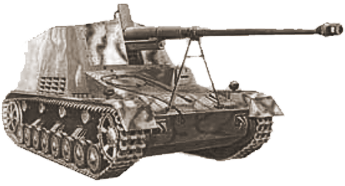Planning the Soviet Assault on Berlin
By April of 1945, whatever Hitler may have hoped for, the European War's end game was at hand. The Red Army's clearing operations in Silesia and Pomerania had crushed any German resistance capable of threatening a Soviet drive on Berlin, and the stage was set for the long awaited direct assault on the German capital. The overwhelming bulk of the German Wehrmacht concentrated along the Oder River, Neisse River and the Czech border. Germany left far weaker armies in the west to face the allies. All told, some 1.6 million German soldiers and 850 tanks in Army Group Vistula and Army Group Center prepared to defend Berlin and Saxony.
On April 1, 1945, Stalin pitted Zhukov and Konev against each other in an egotistical race to take Berlin. Stavka scheduled the attack to begin on April 16, 1945 and planned for the campaign to reach completion within approximately two weeks. Stalin placed additional pressure on his senior military leadership when he considerably accelerated the planned timetable in light of Allied success in the west. Nevertheless, the focus was always on Berlin. Only after seizing Berlin would the Red Army deal with the bulk of Army Group Center, then located in Czechoslovakia. Throughout April's first two weeks both Konev and Zhukov frantically prepared their respective assaults. Meanwhile, just to the north of Zhukov's armies, Rokossovsky, still clearing fanatical German defensive efforts in Prussia, received orders to wheel his 2nd Belorussian Front to the west in order to cover Zhukov's northern flank.
Terrain worked for and against the Red Army. On one hand, the province of Brandenburg, where Berlin was located, featured mostly flat, sandy, easily traversable terrain. Nonetheless, unlike earlier offensives, the Russian plans faced considerable restrictions imposed by Berlin's looming presence as a huge urban center spreading across the 35 miles separating Berlin's heart from the front. Consequently, The Red Army gathered enormous resources to force crossings over the Oder and Neisse Rivers and envelope Berlin. Berlin was a well-built, modern city, with strong buildings, an underground subway network, and in spite of relentless Allied bombing, some 75% of the city remained intact early in April 1945. The quarter of the city destroyed by allied bombing only made things harder for the Red Army; the rubble and shattered buildings provided excellent cover for Berlin's defenders.
Remarkably, Hitler had prepared only a relatively weak defensive force to assist his last stand. To defend Berlin's direct approaches Army Group Vistula fielded 320,000 men in the Third Panzer Army and Ninth Army. These armies featured few first class divisions. Only the 18th Panzer Division, SS Nordland Division, and elements from the Ninth Parachute Division, 20th Panzer Grenadier Division and SS Wallonien Division, along with some Heavy Tank Battalions stood out for their combat abilities. In total, the Germans could only field 754 tanks and 750 guns to defend Berlin. Meanwhile, 380,000 German men and hundreds of tanks and assault guns sat in the Courland pocket or vainly awaited an Allied invasion of Norway.
Regardless, of the poor quality of the German army facing the Russians, the Red Army knew the sacrifice taking a city entailed and massed tens of thousands of artillery pieces to support the offensive. Huge amounts of bridging equipment and enormous ammunition dumps were set up to fuel the twin assaults on the city. Konev had orders to drive his 1st Ukrainian Front south of the city while Zhukov's 1st Belorussian Front would advance directly on Berlin. All told, 2.5 million men and 6,250 tanks prepared to take the German capital. On April 20th Rokossovksy would join the attack to the north of Zhukov. Rokossovsky faced the daunting task of crossing the lower Oder at its split near the Baltic, with flooded marshland in between the river's two branches. It was here where German defensive efforts received a boost from the presence of the brilliant General Manteuffel; albeit commanding the pitiful 105,000 man strong remnants from the shattered Third Panzer Army.
Zhukov's assignment was even more difficult than Rokossovsky's as Zhukov needed to conquer the Seelow Heights overlooking the Soviet bridgehead over the Oder River, no easy task as the Germans had prepared substantial defensive positions reaching nearly sixty miles in depth if one includes Berlin and its suburbs. To assist in breaching the German defenses Zhukov prepared a short but intense artillery barrage, in order to maintain surprise, but also proving the very definition of "shock and awe" as Zhukov ordered up 7,147,000 artillery rounds so the nearly 10,000 massed guns could fire without pause through the initial assault's duration. The Germans facing Zhukov countered however, at the behest of the Ninth Army's commander Heinrici - one of Germany's better defensive specialists - by withrdrawing the bulk of the Ninth Army to its second line of defenses thereby ostensibly avoiding the brunt of the Soviet onslaught.
Konev took a different tack than did Zhukov. Konev chose to cover his assault engineers with a rolling artillery barrage that would rank as one of the most massive displays of concentrated bombardment in the War. Konev's barrage was scheduled to last 145 minutes, with liberal use of smoke, and fired from tens of thousands of rockets, mortars, and artillery pieces massed at nearly 300 per kilometer of front - a stupendous display of firepower. With the Red Army's preparations completed, on the morning of April 16th one of the bloodiest battles in history began.
by Steven Douglas Mercatante



Post new comment